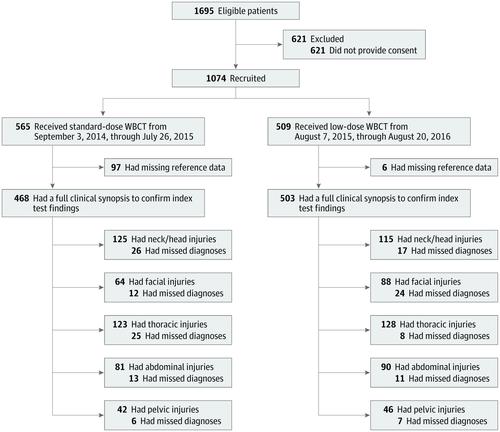当前位置:
X-MOL 学术
›
JAMA Surg.
›
论文详情
Our official English website, www.x-mol.net, welcomes your
feedback! (Note: you will need to create a separate account there.)
Association of Low-Dose Whole-Body Computed Tomography With Missed Injury Diagnoses and Radiation Exposure in Patients With Blunt Multiple Trauma.
JAMA Surgery ( IF 15.7 ) Pub Date : 2020-01-15 , DOI: 10.1001/jamasurg.2019.5468 Dirk Stengel 1, 2, 3 , Sven Mutze 4, 5 , Claas Güthoff 1 , Moritz Weigeldt 1 , Konrad von Kottwitz 2 , Domenique Runge 1 , Filip Razny 4 , Anna Lücke 4 , Dirk Müller 6 , Axel Ekkernkamp 2, 3, 7 , Thomas Kahl 4
JAMA Surgery ( IF 15.7 ) Pub Date : 2020-01-15 , DOI: 10.1001/jamasurg.2019.5468 Dirk Stengel 1, 2, 3 , Sven Mutze 4, 5 , Claas Güthoff 1 , Moritz Weigeldt 1 , Konrad von Kottwitz 2 , Domenique Runge 1 , Filip Razny 4 , Anna Lücke 4 , Dirk Müller 6 , Axel Ekkernkamp 2, 3, 7 , Thomas Kahl 4
Affiliation

|
Importance
Initial whole-body computed tomography (WBCT) for screening patients with suspected blunt multiple trauma remains controversial and a source of excess radiation exposure.
Objective
To determine whether low-dose WBCT scanning using an iterative reconstruction algorithm does not increase the rate of missed injury diagnoses at the point of care compared with standard-dose WBCT with the benefit of less radiation exposure.
Design, Setting, and Participants
This quasi-experimental, prospective time-series cohort study recruited 1074 consecutive patients admitted for suspected blunt multiple trauma to an academic metropolitan trauma center in Germany from September 3, 2014, through July 26, 2015, for the standard-dose protocol, and from August 7, 2015, through August 20, 2016, for the low-dose protocol. Five hundred sixty-five patients with suspected blunt multiple trauma prospectively received standard-dose WBCT, followed by 509 patients who underwent low-dose WBCT. Confounding was controlled by segmented regression analysis and a secondary multivariate logistic regression model. Data were analyzed from January 16, 2017, through October 14, 2019.
Interventions
Standard- or low-dose WBCT.
Main Outcomes and Measures
The primary outcome was the incidence of missed injury diagnoses at the point of care, using a synopsis of clinical, surgical, and radiological findings as an independent reference test. The secondary outcome was radiation exposure with either imaging strategy.
Results
Of 1074 eligible patients, 971 (mean [SD] age, 52.7 [19.5] years; 649 men [66.8%]) completed the study. A total of 114 patients (11.7%) had multiple trauma, as defined by an Injury Severity Score of 16 or greater. The proportion of patients with any missed injury diagnosis at the point of care was 109 of 468 (23.3%) in the standard-dose and 107 of 503 (21.3%) in the low-dose WBCT groups (risk difference, -2.0% [95% CI, -7.3% to 3.2%]; unadjusted odds ratio, 0.89 [95% CI, 0.66-1.20]; P = .45). Adjustments for autocorrelation and multiple confounding variables did not alter the results. Radiation exposure, measured by the volume computed tomography dose index, was lowered from a median of 11.7 (interquartile range, 11.7-17.6) mGy in the standard-dose WBCT group to 5.9 (interquartile range, 5.9-8.8) mGy in the low-dose WBCT group (P < .001).
Conclusions and Relevance
Low-dose WBCT using iterative image reconstruction does not appear to increase the risk of missed injury diagnoses at the point of care compared with standard-dose protocols while almost halving the exposure to diagnostic radiation.
中文翻译:

低剂量全身体计算机断层扫描技术与钝性多发性创伤患者漏诊和漏诊的关联。
重要性最初的全身计算机断层扫描(WBCT)用于筛查疑似钝性多发性创伤的患者仍然是有争议的,并且是过度辐射暴露的来源。目的确定使用迭代重建算法进行的低剂量WBCT扫描与标准剂量WBCT相比,在照护点是否不会增加漏诊的漏诊率,从而减少辐射暴露。设计,背景和参与者这项准实验性前瞻性时间序列队列研究从2014年9月3日至2015年7月26日在德国的一个学术性大都会创伤中心招募了1074名因怀疑是钝性多发性创伤而入院的连续患者。 -剂量协议,并且从2015年8月7日到2016年8月20日为低剂量协议。预期有556名疑似钝性多发性创伤的患者接受了标准剂量的WBCT,随后有509例接受了小剂量的WBCT。混杂是通过分段回归分析和次级多元逻辑回归模型控制的。分析了2017年1月16日至2019年10月14日的数据。干预标准或小剂量WBCT。主要结果和措施主要结果是使用临床,外科和放射学概述作为独立参考测试的护理点漏诊诊断的发生率。次要结果是采用两种成像策略的放射线照射。结果1074名合格患者中,有971名(平均[SD]年龄,52.7 [19.5]岁; 649名男性[66.8%])完成了研究。共有114例(11.7%)患有多处创伤,由伤害严重度得分16或更高定义。在低剂量WBCT组中,标准剂量时有漏诊诊断的患者比例为468例中的109例(23.3%)和503例中的107例(21.3%)(风险差异为-2.0%[ 95%CI,-7.3%至3.2%];未调整的优势比,0.89 [95%CI,0.66-1.20]; P = 0.45)。自相关和多个混杂变量的调整不会改变结果。通过体积计算机断层摄影剂量指数测量的放射线暴露量从标准剂量WBCT组的中位数11.7(四分位间距,11.7-17.6)mGy降低到低剂量下的5.9(四分位间距,5.9-8.8)mGy。剂量WBCT组(P <.001)。
更新日期:2020-03-19
中文翻译:

低剂量全身体计算机断层扫描技术与钝性多发性创伤患者漏诊和漏诊的关联。
重要性最初的全身计算机断层扫描(WBCT)用于筛查疑似钝性多发性创伤的患者仍然是有争议的,并且是过度辐射暴露的来源。目的确定使用迭代重建算法进行的低剂量WBCT扫描与标准剂量WBCT相比,在照护点是否不会增加漏诊的漏诊率,从而减少辐射暴露。设计,背景和参与者这项准实验性前瞻性时间序列队列研究从2014年9月3日至2015年7月26日在德国的一个学术性大都会创伤中心招募了1074名因怀疑是钝性多发性创伤而入院的连续患者。 -剂量协议,并且从2015年8月7日到2016年8月20日为低剂量协议。预期有556名疑似钝性多发性创伤的患者接受了标准剂量的WBCT,随后有509例接受了小剂量的WBCT。混杂是通过分段回归分析和次级多元逻辑回归模型控制的。分析了2017年1月16日至2019年10月14日的数据。干预标准或小剂量WBCT。主要结果和措施主要结果是使用临床,外科和放射学概述作为独立参考测试的护理点漏诊诊断的发生率。次要结果是采用两种成像策略的放射线照射。结果1074名合格患者中,有971名(平均[SD]年龄,52.7 [19.5]岁; 649名男性[66.8%])完成了研究。共有114例(11.7%)患有多处创伤,由伤害严重度得分16或更高定义。在低剂量WBCT组中,标准剂量时有漏诊诊断的患者比例为468例中的109例(23.3%)和503例中的107例(21.3%)(风险差异为-2.0%[ 95%CI,-7.3%至3.2%];未调整的优势比,0.89 [95%CI,0.66-1.20]; P = 0.45)。自相关和多个混杂变量的调整不会改变结果。通过体积计算机断层摄影剂量指数测量的放射线暴露量从标准剂量WBCT组的中位数11.7(四分位间距,11.7-17.6)mGy降低到低剂量下的5.9(四分位间距,5.9-8.8)mGy。剂量WBCT组(P <.001)。











































 京公网安备 11010802027423号
京公网安备 11010802027423号